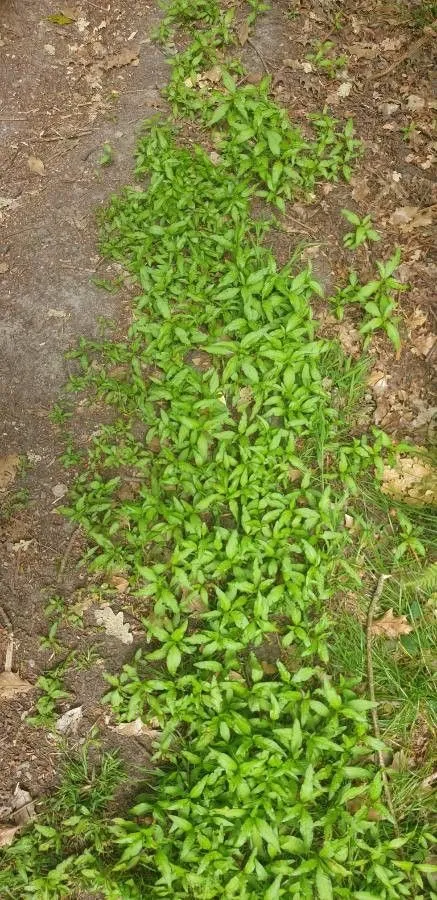
Author: (L.) Delarbre
Bibliography: Fl. Auvergne, ed. 2: 518 (1800)
Year: 1800
Status: accepted
Rank: species
Genus: Persicaria
Vegetable: False
Observations: NW. Africa, Temp. Eurasia to W. & C. Malesia, Australia
Marsh-pepper smartweed, scientifically known as Persicaria hydropiper, is a distinctive species belonging to the family Polygonaceae. Originally documented in the bibliography Fl. Auvergne, ed. 2: 518 (1800) by (L.) Delarbre, this plant has garnered attention for its widespread presence and unique characteristics.
This plant is predominantly found in a variety of wet habitats across Northwest Africa, temperate Eurasia, extending all the way to Western and Central Malesia, and even reaching as far as Australia. Its preference for moist environments underscores its adaptability and resilience, thriving in marshlands, riverbanks, and other wetland ecosystems.
Persicaria hydropiper is known for its sharp, peppery taste, which has led to its common name of marsh-pepper smartweed. This pungent flavor has historically made it a valuable plant for culinary and medicinal uses. The sharpness of its taste is attributed to the presence of certain compounds in its leaves, which can provide a spicy kick when used in cooking.
Beyond its culinary uses, Persicaria hydropiper has also been noted for its medicinal properties. Traditional medicine often incorporates parts of the plant to treat various ailments, taking advantage of its purported anti-inflammatory and antiseptic qualities.
As a member of the Polygonaceae family, marsh-pepper smartweed shares common characteristics with other plants in the family, such as the presence of ocreae—sheaths that encircle the stems at the nodes. Its small, greenish flowers form dense, spike-like inflorescences, which later develop into dark, hard seeds. These seeds can be dispersed by water, aiding the plant’s ability to colonize new areas.
In terms of its ecological role, Persicaria hydropiper serves as an important component of the wetland flora. It provides habitat and food for various wildlife, contributing to the biodiversity of the ecosystems it inhabits. Moreover, its robust growth can help stabilize soil and prevent erosion in its natural habitats.
Overall, marsh-pepper smartweed, or Persicaria hydropiper, stands out as a versatile and ecologically significant plant with historical and practical applications that span culinary, medicinal, and environmental domains.
Es: Chilillo, Persicaria acre, Persicaria picante, Pimienta acuática, Pimienta del agua, Pimienta de agua
Deu: wasserpfeffer, wasserpfeffer-knöterich
Eng: water-pepper, waterpepper
Nld: waterpeper
En: Marsh-pepper smartweed, Water-pepper, Redleaf, Smartweed, Mild Water-Pepper, Marshpepper knotweed, Marshpepper smartweed, Water pepper, Annual smartweed, Common smartweed, Marsh waterpepper, Mild waterpepper, Waterpepper, Biting Persicaria, Marshpepper
Ar: فلفل الماء
Hy: Մատիտեղ ջրային
Az: Subibəri
Ba: Һыу боросо
Eu: Ur-piper
Be: Драсён перцавы
Bn: বিষকাটালী
Bg: Обикновено пипериче
Ca: Pebre de l’aigua, Pebre d’aigua
Zh: La liao, 水蓼
Hr: Paprac
Cs: Rdesno peprník
Da: Bidende pileurt
Nl: Waterpeper, Bittertong, Duizendknoop
Fi: Katkeratatar
Fr: Renouée poivre-d’eau, Poivre d’Eau, Renouee Poivre d’eau, Renouée Poivre d’eau, Curage, Persicaire âcre, Piment aquatique
Ka: Წალიკა
De: Wasserpfeffer, Flohpfeffer, Pfeffer-Knöterich, Pfefferknöterich, Wasserpfeffer-Knöterich
Hu: Borsos keserűfű
Is: Piparsúra
Ga: Biorphiobar
It: Pepe d’acqua, Poligono pepe d’acqua, Pepe d’asino, Poligono acre, Poligono piperino
Kk: Бұрыш самалдық
Ko: 여뀌
Lv: Ūdenspipars
Se: Rihčanjuolas
No: Vasspepar
Os: Цывзыгæрдæг
Fa: فلفل آبی
Pl: Pieprz wodny, Rdest ostrogorzki, Rdest wodny
Pt-br: Pimenta-d’água, Erva-de-bicho
Ro: Dintele-dracului, Piper de baltă
Ru: Водяной перец, Горец перечный
Sk: Horčiak pieprový
Sv: Bitterpilört, Bitterblad, Vattenpeppar, Jungfrutvål
Zh-tw: 水蓼
Tg: Занҷабили обӣ
Tr: Su biberi
Uk: Гірчак перцевий, Перець водяний, Перець собачий
Vi: Nghể, Rau nghể, Răm nước, Thuỷ liễu, Thủy liễu
Cy: Y dinboeth, Llys y Din, Llysiau’r Din, Penboeth, Pupur y Dwfr, Tinboeth
© copyright of the Board of Trustees of the Royal Botanic Gardens, Kew.
© copyright of the Board of Trustees of the Royal Botanic Gardens, Kew.
© copyright of the Board of Trustees of the Royal Botanic Gardens, Kew.
Taken Apr 7, 2021 by John Tan (cc-by-sa)
Taken Jan 24, 2022 by nathan parry (cc-by-sa)
Taken Jan 24, 2022 by nathan parry (cc-by-sa)
Taken Aug 20, 2019 by Saul Baga (cc-by-sa)
Taken Dec 15, 2020 by EMYLIANA HUSSIN (cc-by-sa)
Taken Oct 21, 2019 by Manfred van Treek (cc-by-sa)
Taken Sep 3, 2019 by Chlad Martin (cc-by-sa)
Taken Oct 14, 2020 by 中里園庭 (cc-by-sa)
Taken Sep 11, 2022 by Sarayu Weidner (cc-by-sa)
Taken Feb 10, 2022 by Diego hernandez (cc-by-sa)
Taken Sep 1, 2019 by Peter V (cc-by-sa)
Taken Jul 12, 2022 by ANJA Becker (cc-by-sa)
Taken Aug 25, 2019 by ANJA Becker (cc-by-sa)
Taken Sep 19, 2020 by Z. Magda (cc-by-sa)
Taken Oct 18, 2021 by Emily de Grace (cc-by-sa)
Taken Aug 11, 2021 by Eric DULON (cc-by-sa)
Taken Aug 12, 2022 by Diego Pilato (cc-by-sa)
Taken Jul 28, 2021 by Václav Meškan (cc-by-sa)
Taken Aug 12, 2020 by Estelle Harris (cc-by-sa)
Taken Jun 4, 2020 by Wesley McCullough (cc-by-sa)
Taken Aug 12, 2020 by Estelle Harris (cc-by-sa)
Taken Aug 21, 2021 by Alexis Dumoulin (cc-by-sa)
Taken Jun 28, 2020 by Macarie Monica (cc-by-sa)
Taken Nov 7, 2020 by marco carra (cc-by-sa)
Taken Oct 18, 2021 by Emily de Grace (cc-by-sa)
Ph maximum: 7.0
Ph minimum: 6.5
Light: 5
Atmospheric humidity: 8
Soil nutriments: 7
Family: Myrtaceae Author: (F.Muell.) K.D.Hill & L.A.S.Johnson Bibliography: Telopea 6: 402 (1995) Year: 1995 Status:…
Family: Rubiaceae Author: Pierre ex A.Froehner Bibliography: Notizbl. Bot. Gart. Berlin-Dahlem 1: 237 (1897) Year:…
Family: Sapindaceae Author: Koidz. Bibliography: J. Coll. Sci. Imp. Univ. Tokyo 32(1): 38 (1911) Year:…
Family: Asteraceae Author: A.Gray Bibliography: Pacif. Railr. Rep.: 107 (1857) Year: 1857 Status: accepted Rank:…
Family: Fabaceae Author: Medik. Bibliography: Vorles. Churpfälz. Phys.-Ökon. Ges. 2: 398 (1787) Year: 1787 Status:…
Family: Aspleniaceae Author: (Cav.) Alston Bibliography: Bull. Misc. Inform. Kew 1932: 309 (1932) Year: 1932…